August 16+17, 2010, DIS, Arhus, Denmark
2 days, 10 participants
Open to DIS conference participants (limited number of workshop-only registrations)
No previous electronics or textiles experience necessary!
To attend the workshop participants submitted a one page proposal based on the workshop description.
This workshop will explore the use of low-cost materials and tools to build textile-based interfaces that replace the current hard-shell computer mice or laptop touch-pads that you use to navigate your screen. We will introduce a range of methods for handcrafting textile input devices. Participants will learn techniques developed by the workshop leaders and will also be encouraged to use our materials library to design their own custom mice. The goal of the workshop is to familiarize participants with available electronic textile materials, to introduce them to a variety of sensor and circuitry construction techniques and get people thinking about different interfaces that allow you interact differently with everyday technology.

We will begin the workshop by introducing participants to a range of low-cost and widely available textile materials that have interesting electrical characteristics. We will demonstrate how these materials can be employed to build an assortment of textile circuits and sensors. Participants will then begin to realize their customized computer mouse interface. The above image shows examples of some of the sensors we will introduce.
We expect that participants to explore the physical and electrical properties of many of the materials and experiment with how these properties can be leveraged in a variety of sensing and interaction contexts. Collaboration between participants is encouraged, along with the inclusion of participants’ professional or hobbyist skills. Participants are also welcome to bring materials and tools that they would like to share, demonstrate or use.
The materials for this workshop were sourced and selected because of their availability and price and include conductive and resistive fabrics and yarns, metal fasteners, beads, fusible glues, fabric glues and neoprene. The LilyPad Arduino will be introduced as a computing platform designed to be integrated in textile circuitry. We will use the LilyPad Arduino to fake the input from a standard mouse and use the Arduino programming environment to program these circuits. Participants will write code that customizes the sensor input for their personalized interface.
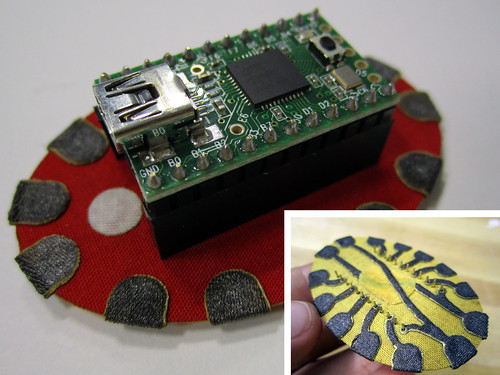
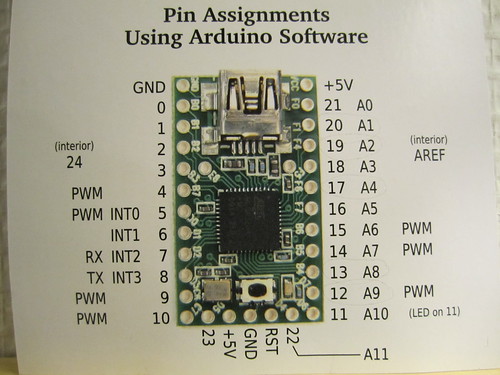

LINKS
>> Download: Participant proposals
>> Download: Powerpoint presentation
>> Teensy: Workflow
>> Teensy: Sewable Fabric Breakout
>> Example: Mouse in a Hole
>> How To Get What You Want
>> Workshop Flickr set
>> High-Low Tech website
>> Teensy website
>> Arduino website
PROJECTS
Matthias Betz “Landmarke Slider”
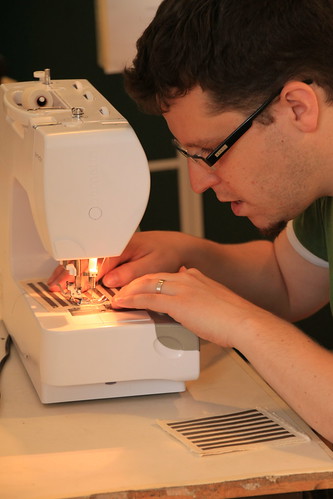
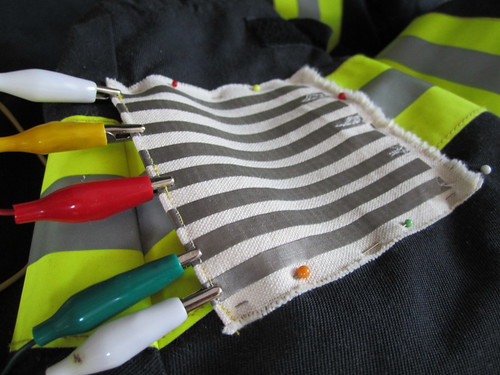
Tracy Hammond “Tight Fitting Bracelet”
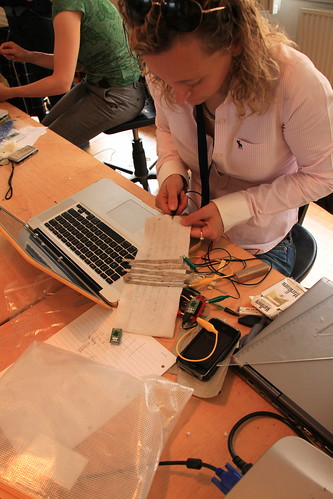

Anita Bacic “A Touch Piece”
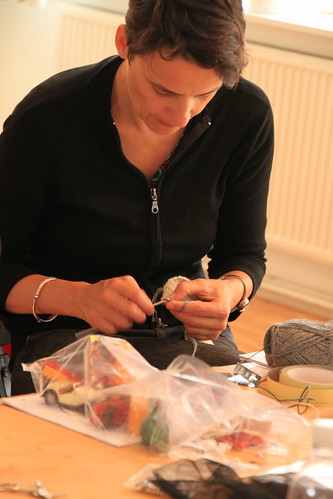

Tanja Doering “3 Textile Mice”
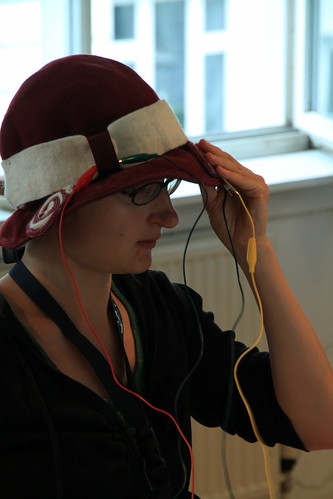
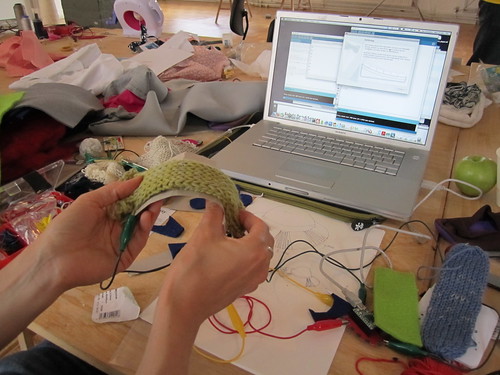
Anna Vallgårda, Delia Dumitrescu, Anna Persson “Stretch and Squeeze”
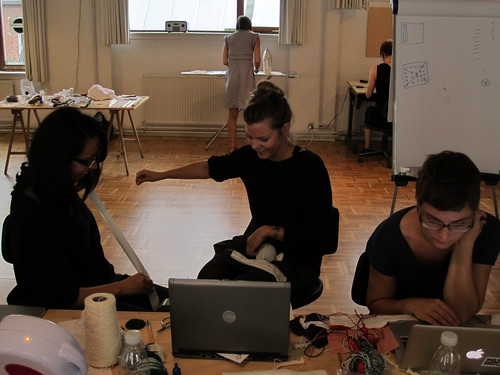

Lone Koefoed Hansen “Skype Hat”


Valerie Lamontagne “Mini Mouse!”

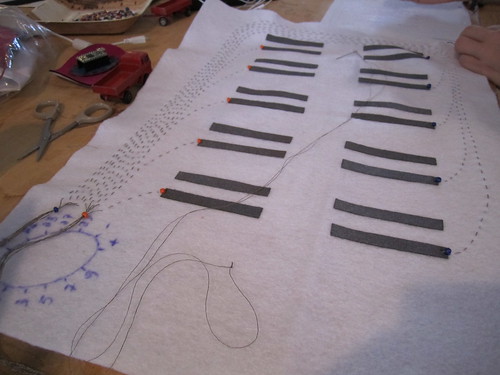
MATERIALS and TOOLS
The following materials and tools will be available during the workshop. Unfortunately there is no materials budget for the workshop so we will ask that you return the Teensy module or buy it from us for 20US$ (115DKK). We will provide you with a fabric breakout board for the Teensy that you can integrate in your project and keep for free.
Teensys are also available from: Adafruit Industries and PJRC for roughly 20US$.
Materials:
– fabric breakout-board for Teensy
– stretch and non-stretch conductive fabric
– thick and thin conductive thread
– resistive thread
– resistive yarn
– Velostat (piezoresistive plastic)
– selection of regular fabric
– selection of regular sewing thread
– selection of regular yarn
– neoprene
– fusible interfacing (fabric glue)
– gaffer tape
– fabric glue, anti-fray
– assortment of metal beads
– assortment of plastic beads
Tools:
– Teensy
– sewing machine
– iron and board
– sewing needles
– knitting needles
– crochet hooks
– circular knitting machines
– scissors
– soldering station
– bread boards
– jumper wires
– aligator clips
– pompom makers
SCHEDULE
Day 1, morning
We will introduce participants to the full range of sensors and textile circuitry techniques that we have previously developed. Participants will then pick a sensor to construct using existing templates or creating a modified version using their understanding of the technique and their own design. After creating their first sensor, participants will be introduced to the LilyPad/Teency setup. We will demonstrate how to connect their sensor and how to program the microcontroller using the Arduino programming environment.
Day 1, afternoon
Once participants have a basic understanding of the techniques for constructing the textile sensors and the hardware involved they will begin to brainstorm, sketch and discuss ideas for their mouse interfaces. Participants will present their ideas and we will help them decide on a final version and how it can be realized. Participants start work on realizing their mouse interface.
Day 2, morning
Quick summary of work from previous day. Participants continue working and by midday should have completed a functioning prototype.
Day 2, afternoon
The afternoon is reserved for developing personal mice. Participants may choose to test their mice by trying to complete some of the regular tasks that they normally use their standard mice for. The idea is to evaluate whether after some amount of practice with the interface, the user is able to improve their mastery of the interface. Participants are welcome to exchange interfaces among themselves to make improvement suggestions.
Half an hour before the workshop ends, participants will demonstrate their outcome to one another and explain their making processes. We expect that participants will leave the workshop with a functioning prototype that they constructed.
people
Hannah Perner-Wilson
Leah Buechley
